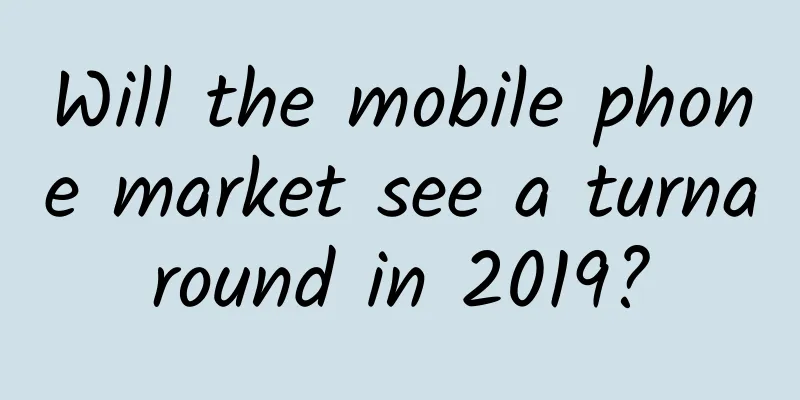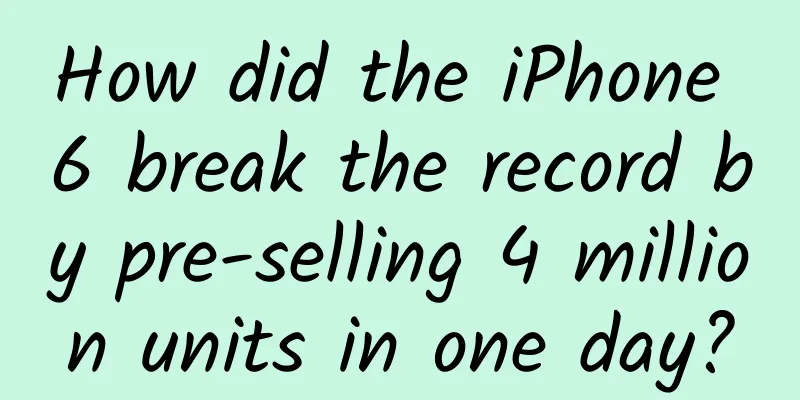Will the mobile phone market see a turnaround in 2019?

|
2018 is already last year. The winter was too cold, 2018 finally passed, 2019 has quietly arrived, but winter is still not over, is spring far away? On the first day of 2019, we still have high hopes and hope to find the motivation to start again.
Mobile phone market in 2018: market cooling, chrysanthemums blooming, and other flowers withering There is no need to bring up those bleak figures for the mobile phone market in 2018 (especially compared with the booming days in previous years). The industry has already felt the coldness of the market frost (double frost), and what is even more chilling is that there may be no hope of reversing this trend. 1. The competition fence of leading brands is getting tighter After the top brands completed their harvest of others and second-tier brands, the top brands consisting of Huawei, vivo, OPPO, Honor, Apple, and Xiaomi have opened up a market share gap of more than 10 percentage points with the second camp, and the market fence of the top camp is becoming increasingly tight. The threshold for ecological competition among top brands is getting higher and higher, from the original brand + product + channel to multiple brands + multiple categories + new retail + supply chain control + self-developed chips + new technology innovation (including standards) + big data + AI + cloud applications + ... and the all-round ecological competition is still being superimposed. The threshold is getting higher, and it is more difficult for small and medium-sized brands to counterattack and grow into top brands. 1) Huawei’s “trend”: the only big winner Judging from the results, Huawei's performance in 2018 is excellent, and the industry is full of praise. In 2018, Huawei's series truly ushered in a leap in quality (*** power) and quantity (200 million), and it was almost impervious to the cold, and it was the only big winner in the market. Huawei and Honor are operating a full range of dual brands and have entered a period of harvest for technological innovation. New technologies are emerging: Leica triple-camera, AI chip Kirin 980, liquid cooling + graphene heat dissipation, GPU Turbo, extreme full screen, Link Turbo... New products are amazing: P20 series, mate20 series... The product power/price is close to Apple, and there are constant surprises, which dazzles the market; the Meng Wanzhou incident has made the world realize that Huawei has reached a point where its competitors can only respond in this way, especially in the 5G field. If there is a share of power, Huawei's power is far stronger than its market share. Imagine what it would be like if the future market became a civil war between Huawei, Honor, and Nova? To become the king of the smart full-scenario industry, this vision seems very natural. There is no way around it, it’s just awesome. 2) Changes of OV: Brand, R&D, IoT If there is no comparison with Huawei, OPPO and vivo also had an excellent year in 2018. The technological image of both brands has been greatly improved, and they have entered the high-end market competition circle. They have all felt the chillness of the offline market and started to develop online products. They have all begun to pay attention to the application of new technologies and show off their technological strength. In comparison, vivo's pace is more accurate. Everyone realizes that the trend requires them to shift from single product categories to pan-terminals. With such widespread pan-intelligence, as a latecomer in the IoT field, where are the opportunities? How many of our users' effective IoT needs have been taken away by other ecosystems? The stock of mobile phones is the basic foundation for survival in the era of competition. Whether the outflow trend of main stock models caused by precise attacks from major competitors can be alleviated will become the key to subsequent trends. Can the market give enough time for R&D investment to be transformed into new technological innovation? Can the heavy assets of channels be effectively transformed and upgraded to become the lever for the IoT chessboard? In the cold winter, OV's transformation and upgrading comes at the right time and does not come at the right time. It requires strategic determination and market opportunities. 3) Xiaomi’s “blandness”: IPO, blandness, IoT The first thing Xiaomi did in 2018 was naturally to go public, which is crucial to the sustainability of the entire ecosystem, although it was a bit unfortunate as it encountered a cold wave in the capital market. The camera, the biggest highlight of the mobile phone, makes up for the shortcomings, which is not easy. However, it is a little behind in the pace of applying the hot new technologies in the industry, lacking the freshness and surprise that Xiaomi once brought us. This reflects the lack of overall R&D strength and supply chain control. Just like taking pictures, it needs to be done one by one. How much can the cooperation with Meitu earn from female customers? Does the Sony high-end Walkman player that Lei Jun showed off mean that he is going to make a push in the music field? This will take time! Fortunately, we are already in the circle of leading manufacturers. The bad news is that the head manufacturers need more real competition to fight each other. The cruelty of the market and the shift of users are often faster than you think. Moving forward amid controversy, Xiaomi's IoT ecosystem has gradually taken shape, with Xiao Ai becoming another core, and the window of opportunity for AI voice in All has opened. The IoT field is still in its incubation period, and it will take time to become a new growth pole. Facing the full-scale attack from Huawei, Xiaomi IoT will also be under pressure and needs to continue to run fast. 4) Apple’s “danger”: bangs, affordable luxury, and order cuts Apple's crisis seems to have come unexpectedly, but also seems to be so natural. With the inertia of lack of innovation, users' patience will always have an end, not to mention that there are many wolves around. After Apple stagnated after introducing the notch, Chinese partners have continued to push the Almost Full Screen design innovation to new heights. Even the late feature of the new iPhone, the dual-SIM card, did not offset the high price due to the lack of innovation. Compared with the absolute value of the price increase, Apple's increase is actually okay, but it cannot withstand the high absolute price and the continued support of Chinese partners. It doesn't matter who is the biggest reason for the dismal sales of Apple's new products in the domestic market. What matters is that the Apple myth is being broken. Under the general trend, the plummeting capital market cannot be attributed only to products, but the supply chain's order cuts have made the supply chain feel no less chill than the capital market. Apple has launched an unprecedented trade-in promotion. Will the feud with Qualcomm lead to a lag in the 5G era? This has led to doubts about Apple's prospects. Apple is still excellent, but the faith in Apple is wavering. Apple needs an innovative product more than ever to prove its competitiveness. Will it be in 2019? Promotions and low-priced iPhones are just a temporary solution, because once faith is gone, the only thing that will come is a collapse in market performance. 2. Second-tier manufacturers feel powerless. Has the concept of small and beautiful been proven to be a false concept in the mobile phone market? The market has entered a stage where top brands compete with each other. The market space released by the failure of top brands in competition is absorbed by other top brands. Segmented markets still exist, but the comprehensive series of products of top brands are gradually replacing the segmented markets dominated by small and medium-sized brands, leaving less space for small and beautiful manufacturers. Perhaps in the mobile phone market, small and beautiful is a pseudo-***. Small is small, but where is the beauty? What is the beauty? After the innovation of mobile phones has entered the deep water period, it is more driven by giants, and these are no longer what small brands can do. The song ends and people disperse. Perhaps leaving in time is also the act of the brave. Under the threshold of all-round ecological competition, small and medium-sized brands are facing a crisis of independent survival. Whether they have the support of a large parent company determines the brand's ability to resist risks and future development potential. Impression of several brands: Meizu: A specialty brand that is closest to the top brands in terms of scale, but Meizu always jokes with you when you are optimistic about it, but it has always existed stubbornly. The beauty of Meizu 16 is in sharp contrast with the pain of the supply chain. Although capital such as Alibaba has intervened, the continued turbulent internal management makes people dare not continue to be optimistic about its future. OnePlus: Focusing on flagship products, operating light-asset business on the Internet, or sharing OPPO supply chain resources, which is the key to success? Lenovo: Actively following new technologies, with a strong desire to return, and maintaining brand influence through online media. If it can continue and further improve its channels and supply chain, it has growth potential. Meitu : Becoming a subsidiary of Xiaomi is a good destination. Let’s forget each other from now on. ZTE: 5G is ZTE's biggest opportunity, but the premise is to do other homework well to maximize the window of opportunity. However, Nubia has made positive explorations in the e-sports game market, double-sided screen mobile phone and other market segments, which is admirable. Hisense: Technology has never been transformed into market power. What is the problem? It seems obvious but difficult to solve? What is the position of IoT and 2B new opportunities in the group company? Hammer: The storm is brewing. Will we see the end or marry into a wealthy family in the near future? Under the general trend of adjustment, the market does not believe in the feelings of the weak. Samsung: The world's No. 1 is still in a dilemma in China, and the mid-range flagship function is intended to break through and reshape its image. China still faces three major difficulties: rebuilding confidence, rebuilding channels, and rebuilding models. Of course, the lack of operation ability reflected by the Supreme incident is a chicken and egg problem between the three levels. Nokia: Can it make a comeback? Do you believe it? What is it based on? How much faith does Nokia still have?
1. The stage in 2019 continues to shrink, and the pattern is unlikely to change dramatically. Huawei is certain to rise, so who will fall behind? The overall environment is obviously more uncertain. The economy is in a downward cycle. The manufacturing index has fallen below the boom-bust line. How can the mobile phone industry remain immune for a long time? 2019 is destined to be a tough year. With rapid quality upgrades, 2000+ mobile phone products are already excellent and sufficient. The innovations that can be expected in 2019 are likely to be concentrated on ultra-high flagship models, which is difficult to stimulate the demand for large-scale replacement of mobile phones. The wait-and-see effect brought about by the 5G eve will further amplify the wait-and-see effect. There is really no reason to stimulate the mobile phone market to turn from a decline to a stable or even upward trend. In fact, we should not expect too much. It may not be excessive for the market to continue to decline by more than 10 points compared to 2018. The replacement market is being harvested by giants, consumption is becoming more cautious, and users will tend to rationally choose products from top brands, and the risk-taking consumption will decrease, which will obviously further consolidate the dominance of top manufacturers. After harvesting others and second-tier brands, in the stage of mutual competition among top manufacturers, according to Huawei's upward momentum and technology layout in 2018, continued growth in 2019 is almost certain, and Honor is more optimistic in terms of consumption trends. Whose market share is Huawei eating into? The most noteworthy is Apple, which is also the most valuable to snatch. As mentioned above, 2019 is a turning point for Apple, and it needs to rebuild its faith. If OV's transformation fails to generate new growth potential, it may be under pressure. If pan-intelligence continues to flourish and mobile phones keep up with the pace, Xiaomi's 2019 may not be so bad. 2. 5G: The storm is coming, hold high? Yes! Fight high? No. Wait until the flowers bloom in 2020. Can 5G change the current competitive landscape? Personally, I think 5G is not the core factor in the change of the market structure. If the structure changes during the same period, 5G is more likely to be the trigger. Keeping up with 5G may not be a killer move, but failing to keep up will become a shortcoming and may even lead to elimination. Compared with previous generations of upgrades, the factors that determine the structure of the 4-to-5 generation are more complex and comprehensive. In 2018, mobile phone manufacturers could no longer resist the temptation of 5G. They rushed to open the first 5G data link, make the first call, send the first Weibo, release the 5G version of the PPT machine, and publish the number of patents and manuscripts in the 5G field. This reflects that manufacturers are eager to let consumers know that they are not behind in 5G. The 5G public opinion war will be more intense in 2019, such as the first 5G prototype to be launched. There is nothing wrong with these. It is necessary to hold high the banner, especially for leading manufacturers, who must seize the momentum. But if you really go high, it is obviously stupid. According to the schedule, the 5G market is still in the trial and pre-commercial stage in 2019. The high price is mainly limited by the increase in device hard costs, limited cost sharing and the impact of the network construction stage. The expansion of the 5G mobile phone market depends on three points:
The first two points are difficult to achieve in 2019, but are expected to be achieved in the middle or second half of 2020. From the perspective of domestic market size, the market share in 2019 may be questionable, and driven by competition, it is expected to quickly drop from the 4000+ market to the 3000+ market in 2020, and enter the 2000+ and below market in 2021. Therefore, manufacturers are faced with a dilemma in 2019: on the one hand, they need the momentum of 5G - manufacturers need to make consumers look forward to 5G; on the other hand, they need the reality of 4G - to make consumers forget about 5G and not wait too long to affect the market in 2019. This is also a market variable in 2019. 3. 2B and IoT: How many ecological islands can be accommodated? Are you really ready? In 2018, the industry was dominated by the second half of the game, and the second half of the Internet was typical: the Internet dividend of consumer Internet disappeared, and the future opportunities were in industrial Internet..., and the giants were all planning to transform to the 2B market. With the coming of the 5G era, this trend judgment is even more urgent. AI and IoT are both regarded as core strategies and future focuses by manufacturers. Leading manufacturers are operating in an ecological way. Xiaomi, Huawei, and Honor have already advanced their ecological layout at full speed. As mentioned above, OPPO and vivo have also begun to actively embrace IoT. The pan-intelligence that mobile phone manufacturers are currently deploying is essentially still consumer-grade ToC (including ToHome) pan-intelligence, including smart speakers, routers, smart TVs, smart home appliances, etc. After the devices are connected, they will enter AI+. Mobile phone manufacturers use the sales of pan-intelligence terminals to enter user homes, deploy smart homes, complete the penetration from personal to family fields, and combine big data + cloud applications to complete another pipeline bypass of operators. Terminal manufacturers, BAT Internet, traditional home appliance manufacturers, and operators all need to operate in an ecological way. Can this market accommodate so many ecological giants? The ecological barriers between giants will only increase day by day. This is destined to be a life-and-death market. Among the current terminal manufacturers, Huawei/Honor and Xiaomi are clearly ahead. As latecomers, do OPPO and Vivo still have latecomer advantages? I personally think that the most practical opportunities for OV at present still lie in their strengths: solving the sales problem in the pan-intelligent field and transforming and upgrading channels at the same time, killing two birds with one stone. In the vertical industry field where 5G is truly full of imagination, terminal manufacturers are obviously unfamiliar but full of temptations. They are far behind BAT. How can they cut into the vertical industry cake? As a mobile phone manufacturer, should we ask ourselves whether we are really ready? 4. Products: The innovations of 2019 are unlikely to reach ordinary people, and more experience upgrades are expected in 2020! In 2019, manufacturers' gradual and unremitting improvement of experience will still be the mainstream. Perhaps manufacturers should shift their attention slightly from the camera, screen, and RAM wars to solve the core experience problems of the next wave of phone replacement. 1) Sharp improvement in photo taking experience: never stop Multi-camera, AI, selfie beauty, high pixels, wide angle, super night scene... After the dazzling improvement, the user's sensory experience may be difficult to continue to improve significantly, even with a four-camera or five-camera matrix, but this does not hinder the continuous progress in the field of shooting, which will never stop. 2) The battle of screen-to-body ratio: Have we forgotten our original intention? The screen-to-body ratio war is expected to continue and move toward the mid- and low-end. However, with the screen-to-body ratio approaching 100% in 2018, it is a technological leap, but not necessarily a leap in user experience. We have paid too much for this and have gone too far. Have we forgotten why we started? 3) New flagship appearance: folding screen Folding screens are obviously a must-win for leading manufacturers to seize the upper hand: Samsung, Huawei, OPPO, etc. will all be involved. The gorgeous technological breakthroughs and upgrades, but the actual experience is unknown. The perception of educating consumers is based on two points: 1. The screen is foldable, which looks great and is the biggest selling point; 2. It is a mobile phone when folded and a tablet when opened, 2 in 1. How is the weight (the double-sided screen seems to have been tested)? Is there a new experience? More importantly, the price of folding screen products is out of reach for ordinary consumers in the early stage. 4) Solving the two core experiences is the key to driving 5G phone replacement In 2019-2020, solving the power consumption experience of 5G mobile phones through new materials and new processes is the key premise. In addition to full screen and folding screen, 5G+AI empowerment+cloud application will be the key to the next industrial upgrade and the internal key to drive users to change phones. This is why we can have expectations for the spring of 2020. 5. Cooperation: The eve of 5G ushered in a bonus period for operator cooperation History has proven more than once that every network generation upgrade and switch will bring about changes in the market structure and is a bonus period for cooperation between manufacturers and operators. Keeping up may not necessarily be a killer move, but failing to keep up will inevitably become a shortcoming until being eliminated. 1) Cooperate with operators to win the battle for existing market share Channel cooperation touchpoint upgrade, big data precision marketing... 2) Cooperate with operators to seize the opportunity of 5G mobile phone upgrade With the synchronization of 5G standards, networks, and services, in-depth joint research and development and live network coordination are needed to gain the upper hand. Driven by rapid popularization, operator policies and subsidies are a grab for existing market share. 3) Cooperate with operators to enter the 2B market Terminal research and development in the 5G era integrates services, networks and scenarios, and requires effective industrial collaboration among network equipment vendors, operators, service developers and terminal manufacturers. Different from the large-scale universal demand in the mass market, the demand in vertical fields is fragmented and personalized. Terminal manufacturers, especially IoT smart manufacturers, need to collaborate with operators more in vertical industry fields. Written in ***, Spring will never be late, but more people fall in winter. During the Ice Age, most species could not wait until the ice and snow melted. Since we have been calling for winter for so many years and we have already held the worst expectations, maybe 2019 will not be so cold, and there are still undercurrents under the ice. In the cold winter, if an enterprise can also adjust counter-cyclically, then strengthening the foundation and making up for shortcomings is the way to survive. Only by staying alive can we wait for spring; only by constantly striving for self-improvement can we seize the market starting from 2020 and bloom again. |
<<: Apple's "stubborn" promotion
>>: Alipay, WeChat Pay and other transactions above 50,000 yuan must be reported
Recommend
User growth case analysis: 3 key points for old customers to bring in new ones!
I have recently been researching referrals, which...
As a product grows from 0 to 100, what is operations doing?
When I was in college, I started to get involved ...
Learn Bazi from scratch, learn Bazi Jiugongge from scratch!
Learn Bazi from scratch, learn Bazi Jiugongge fro...
Daily snacking, even small amounts, can reshape your brain
Friends often ask me, if I only eat a little swee...
Apple iOS 16 hidden system exposed: detect user country/region more accurately and restrict specific functions
On April 26, according to foreign media 9to5Mac, ...
Overwork, anxiety and stress are the triggers of sudden death! The truth you must know about sudden death
Recently, the news that a 22-year-old girl in Han...
2020 Changtou Academy Financial Management Full Training Course Video Baidu Cloud Download
2020 Changtou Academy Financial Management Full T...
People's Daily criticized Apple iPhone by name: Why is a mobile phone brand that ranks only fifth in domestic sales so arrogant?
As the iPhone throttling incident ferments around...
Flower arrangement training advertising case!
As a way of life for people to cultivate their ch...
28 classic programming algorithms you must read
The first ten are the top ten algorithms from the...
The underlying design logic of App brand advertising
Written in front This article uses a typical bran...
How to take the "special medicine" when you are infected with influenza B? 10 questions and 10 answers from pharmaceutical experts
Recently, influenza (hereinafter referred to as f...
The transmission and response mechanism of touch events in iOS
All inherited responder objects UIResponder can r...
Snapdragon 625 vs. Helio P20: Which one has better temperature control/performance?
In the mid-range mobile phone market in 2016, mod...
Feeling sleepy in spring, tired in autumn and nappy in summer, it turns out these foods make people feel dizzy!
Review expert: Wu Xinsheng, deputy chief physicia...









